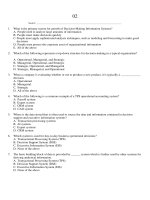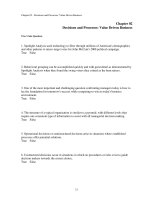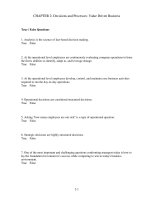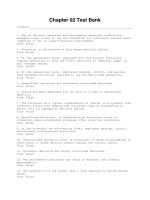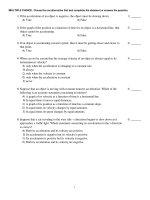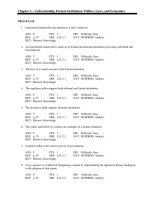Business driven information systems 3rd edition paige baltzan test bank
Bạn đang xem bản rút gọn của tài liệu. Xem và tải ngay bản đầy đủ của tài liệu tại đây (547.86 KB, 163 trang )
Chapter 02 - Decisions and Processes: Value Driven Business
Chapter 02
Decisions and Processes: Value Driven Business
True / False Questions
1. Spotlight Analysis used technology to filter through millions of American's demographics
and other patterns to micro-target votes for John McCain's 2008 political campaign.
True False
2. Behavioral grouping can be accomplished quickly and with great detail as demonstrated by
Spotlight Analysis when they found the swing voters they coined as the barn raisers.
True False
3. One of the most important and challenging question confronting managers today is how to
lay the foundation for tomorrow's success while competing to win in today's business
environment.
True False
4. The structure of a typical organization is similar to a pyramid, with different levels that
require one consistent type of information to assist with all managerial decision making.
True False
5. Operational decisions or semistructured decisions arise in situations where established
processes offer potential solutions.
True False
6. Unstructured decisions occur in situations in which no procedures or rules exist to guide
decision makers towards the correct choice.
True False
2-1
Chapter 02 - Decisions and Processes: Value Driven Business
7. At the strategic decision-making level employees develop, control, and maintain core
business activities.
True False
8. The construction of a new city subway station and the processing of monthly payroll are
both considered types of projects as defined in your text.
True False
9. Key performance indicators can focus on external and internal measurements.
True False
10. The proportion of the market that a firm captures is called market share.
True False
11. Benchmarks are baseline values the system seeks to attain.
True False
12. Effectiveness MIS metrics include throughput, transaction speed, and system availability.
True False
13. Measuring the amount of website traffic is the best way to determine a websites success.
True False
14. MIS support systems rely on models for computational and analytical routines that
mathematically express relationships among variables.
True False
2-2
Chapter 02 - Decisions and Processes: Value Driven Business
15. Streamlining information encompasses all of the information contained within a single
business process or unit of work, and its primary purpose is to support the performing of daily
operational or structured decisions.
True False
16. Sensitivity analysis, what-if analysis, optimization analysis, and market basket analysis
are the common DSS analysis techniques.
True False
17. Digital dashboards offer consolidation, drill-down, and slice-and-dice capabilities.
True False
18. Managers use transactional information when making structured decisions at the
operational level.
True False
19. The manipulation of information to create business intelligence in support of strategic
decision making is referred to as OLTP or online transaction processing.
True False
20. Intelligent systems are various commercial applications of artificial intelligence.
True False
21. A neural network is a category of efficiency metrics where it attempts to measure the way
the human brain works.
True False
2-3
Chapter 02 - Decisions and Processes: Value Driven Business
22. Investment companies use genetic effectiveness metrics to help in trading decisions.
True False
23. A shopping bot is one of the simplest examples of an intelligent agent.
True False
24. At Microsoft's headquarters, to eliminate congestion and save on other business expenses
the company offered employees the option to work virtually from home.
True False
25. Business-facing processes or back-office processes are invisible to the external customer
but essential to the effective management and operation of the business.
True False
26. When evaluating the 5-steps in the order-to-delivery business process, step one includes
creating a campaign and checking inventory, which are both part of the sales function.
True False
27. Strategic planning is a customer-facing business process.
True False
28. Product delivery is a customer-facing business process.
True False
29. Improving the efficiency and effectiveness of its business processes will improve a firm's
value chain.
True False
2-4
Chapter 02 - Decisions and Processes: Value Driven Business
30. A business management system is a graphic description of a process, showing the
sequence of process tasks, which is developed for a specific purpose and from a selected
viewpoint.
True False
31. To-Be process models show the results of applying change improvement opportunities to
the current (As-Is) process model.
True False
32. The primary goal of an As-Is process model is to simplify, eliminate, and improve the ToBe processes.
True False
33. Business processes should never drive MIS choices and should be based on business
strategies and goals.
True False
34. Redundancy occurs when a task or activity is never repeated.
True False
35. Business process reengineering is the analysis and redesign of workflow within and
between enterprises.
True False
36. Business process management systems evaluate and improve processes that include both
person-to-person workflow and system-to-system communications.
True False
2-5
Chapter 02 - Decisions and Processes: Value Driven Business
37. BPM systems include advanced features such as enhanced process modeling, simulation,
execution, and monitoring, providing a high level of flexibility while reducing costs.
True False
Multiple Choice Questions
38. Which of the following is a not a type of organizational information system?
A. Executive information system
B. Decisions support system
C. Analysis processing system
D. Transactional processing system
39. Which of the below is an important challenge facing managers today?
A. Making business decision
B. Solving business problems
C. Competing to win in today's market
D. All of the above
40. What must managers be able to do to compete in today's global marketplace?
A. Make decisions to gain competitive advantages
B. Make decision that can help forecast future business needs
C. Make decision that can help forecast future business requirements
D. All of the above
41. Which of the below is not considered a challenge facing most managers today?
A. Managerial decisions must be made quickly
B. Strategic decisions need to be made by applying analysis techniques
C. Artificial intelligence is required by all managers to be successful
D. Managerial decisions require large amounts of information to analyze
2-6
Chapter 02 - Decisions and Processes: Value Driven Business
42. What was the name of the analysis that Spotlight Analysis did for Barack Obama's 2008
presidential campaign?
A. Visualization
B. Transactional data
C. Data poaching
D. Micro-targeting
43. Which of the following is not included in the decision-making process?
A. Data Collection
B. Solution Benchmarking
C. Solution Generation
D. Solution Test
44. When evaluating the six-step decision making process, what occurs during the solution
implementation step?
A. The process will begin again if the decisions made were incorrect
B. Definition of the problem as clearly and precisely as possible
C. Details of every solution possible including ideas that seem far fetched
D. The solution that best solves the problem is selected
45. When evaluating the six-step decision making process, what occurs during the problem
identification step?
A. The process will begin again if the decisions made were incorrect
B. Definition of the problem as clearly and precisely as possible
C. Details of every solution possible including ideas that seem far fetched
D. The solution that best solves the problem is selected
46. When evaluating the six-step decision making process, what occurs during the solution
selection step?
A. The process will begin again if the decisions made were incorrect
B. Definition of the problem as clearly and precisely as possible
C. Details of every solution possible including ideas that seem far fetched
D. The solution that best solves the problem is selected
2-7
Chapter 02 - Decisions and Processes: Value Driven Business
47. When evaluating the six-step decision making process, what occurs during the solution
test step?
A. The process will begin again if the decisions made were incorrect
B. Definition of the problem as clearly and precisely as possible
C. Details of every solution possible including ideas that seem far fetched
D. None of the above
48. Which of the below represents the structure of a typical organization?
A. Flat line
B. Pyramid
C. Circle
D. Cube
49. Which of the below represents the three different levels of a company pyramid from the
top to the bottom?
A. Managerial-Strategic-Operational
B. Strategic-Managerial-Operational
C. Operational-Managerial-Strategic
D. Strategic-Operational-Managerial
50. Which of the below would you include as decisions and responsibilities typically found at
the managerial level of a company?
A. Monthly Plans
B. Monthly Budgets
C. Weekly Schedule
D. All of the above
51. Which of the below would you include as decisions and responsibilities typically found at
the operational level of a company?
A. Develop core business activities required to run the day-to-day operations
B. Control core business activities required to run the day-to-day operations
C. Maintain core business activities required to run the day-to-day operations
D. All of the above
2-8
Chapter 02 - Decisions and Processes: Value Driven Business
52. Data collection, solution generation, and solution implementation are all concepts
associated with ________________.
A. The six-step problem solving process
B. The six-step decision making process
C. The four-step problem solving process
D. The four-step decision making process
53. Review the below key terms. Which one defines an operational decision that involves
situations where established processes offer potential solutions?
A. Optimization analysis decision
B. Artificial intelligence decision
C. Structured decision
D. Unstructured decision
54. Review the below statements. Which one does not represent an example of a structured
decision?
A. Reordering inventory
B. Deciding to enter a new market
C. Creating the employee weekly staffing schedule
D. Creating the employee weekly production schedule
55. Which of the below is not considered a part of decision making at the managerial level?
A. Developing overall business goals and objectives
B. Creating a short-term budget
C. Allocating resources to a department
D. Monitoring performance of a project team
56. Which of the below key terms represents the types of decisions made at the operational,
managerial, and strategic levels of a company?
A. Structured decisions
B. Unstructured decisions
C. Semistructured decisions
D. All of the above
2-9
Chapter 02 - Decisions and Processes: Value Driven Business
57. The level where managers develop overall business strategies and monitor the
performance of the organization and the competitive business environment is the
___________ level.
A. Operational
B. Strategic
C. Managerial
D. Communications
58. Jenny Welch works at a retail store selling sports equipment. Her daily tasks include
opening the store, creating the work schedules, processing payroll, overseeing sales and
inventory, and training employees. At what level of the organizational pyramid would you
categorize Jenny?
A. Managerial
B. Operational
C. Strategic
D. Owner
59. Andy Benton works at the local Starbucks coffee shop and his responsibilities include
taking orders, fulfilling orders, and ringing in sales. At what level of the organizational
pyramid would you categorize Andy?
A. Strategic
B. Owner
C. Operational
D. Managerial
60. Bill Schultz works at a high power investment firm in Los Angeles. Bill is responsible for
promoting the firm's vision and creating the company-wide goals and strategies. He also
monitors the overall strategic performance of the company and its direction for future
business strategies. At what level of the organizational pyramid would you categorize Bill?
A. Strategic
B. Owner
C. Operational
D. Managerial
2-10
Chapter 02 - Decisions and Processes: Value Driven Business
61. Chuck Norris has been hired to oversee all of the plans that the city of Denver has created
to expand its train transportation system by adding six more lines to the metro area. Chuck
will be responsible for planning the project, managing the processes, and finalizing each new
line as it is completed. How would you categorize the majority of the decisions Chuck will
have to make to complete his job?
A. Unstructured decisions
B. Semistructured decisions
C. Structured decisions
D. Strategic decisions
62. CSF's and KPI's are two core metrics used to evaluate results and measure the progress of
a project for a business. Which of the below represents the acronyms for CSF and KPI?
A. Continual success factors and key performance indicators
B. Critical success factors and key project ideas
C. Customer success findings and key project ideas
D. Critical success factors and key performance indicators
63. What are measurements that evaluate results to determine whether a project is meeting its
goals?
A. Models
B. Metrics
C. Benchmarks
D. Genetic algorithms
64. What are the crucial steps companies perform to achieve their goals and objectives and
implement their strategies?
A. Critical success factors
B. Crucial success factors
C. Key performance indicators
D. Key performance factors
2-11
Chapter 02 - Decisions and Processes: Value Driven Business
65. Which of the below is an example of a critical success factor?
A. Increase customer satisfaction
B. Number of new customers
C. Number of new products
D. Percentage of employee turnover
66. Which of the below statements is accurate?
A. Key performance indicators can have no more than four critical success factors
B. Critical success factors can have no more than four key performance indicators
C. Key performance indicators can have several critical success factors
D. Critical success factors can have several key performance indicators
67. Key performance indicators are the metrics a company uses to evaluate progress toward
critical success factors. Which of the below represents a key performance indicator?
A. Create high-quality products
B. Reduce product costs
C. Percentage of help desk calls answered in the first minute
D. Hire the best business professionals
68. CSF's and KPI's are the two core metrics used within a business to track progress or
success. What is the relationship between CSFs and KPIs?
A. CSF's are business strategy elements where KPI's measure the progress of the CSF's
B. CSF's build the business environment where KPI's explain how to build the CSF's
C. KPI's are used first where CSF's are applied after
D. KPI's promote employees on their performance where CSF's demote employees based on
their performance level
69. Market share measures a firm's external performance relative to that of its competitors.
Which of the following represents how a firm measures market share?
A. Multiplying the firm's sales by the industries total sales
B. Dividing the firm's sales by the total market sales for the entire industry
C. Subtracting your competitors sales from your total sales
D. Subtracting the industries total sales from the firm's total sales
2-12
Chapter 02 - Decisions and Processes: Value Driven Business
70. Anne-Marie Cole runs the sales division for a local auto insurance firm. One of her key
duties is to calculate her company's market share. When evaluating the prior year numbers,
she found that her firm achieved total sales of $3 million and the entire industry had $30
million in sales. What is Anne-Marie's current market share?
A. 1%
B. 10%
C. 18%
D. 20%
71. Anne-Marie Cole runs the sales division for a local auto insurance firm. One of her key
duties is to ensure the company has 10 percent market share by the end of the year. When
evaluating the current sales numbers she determines that her sales division has total sales of
$3 million and the entire industry has total sales of $50 million. What additional sales must
Anne-Marie's division meet to ensure they have 10 percent of the market by the end of the
year?
A. $1 million
B. $2 million
C. $5 million
D. $10 million
72. What type of measurement is using market share as a KPI?
A. Fuzzy logic measurement
B. External measurement
C. Neural network measurement
D. Internal measurement
73. Which of the below represents an internal KPI that indicates the earning power of a
project?
A. Market share
B. Return on intelligent
C. Sensitivity analysis
D. Return on investment
2-13
Chapter 02 - Decisions and Processes: Value Driven Business
74. Todd Haitz is the marketing manager for the National Basketball Association. Todd
analyzes and tracks his marketing campaigns to determine the best success rate per project for
increasing ticket sales. Todd uses an internal KPI to track his marketing campaign success.
Which of the below would be an internal KPI Todd would use to track his marketing
campaigns?
A. Marketing campaign ROI
B. Marketing campaign percentage of fans purchasing Sports Illustrated magazine
C. Marketing campaign advertiser revenue sales
D. Marketing campaign market share
75. What could a manager use to measure the success of an MIS project?
A. Effectiveness MIS metrics, efficiency MIS metrics
B. Effectiveness MIS metrics, expert MIS metrics
C. Expert MIS metrics, executive MIS metrics
D. All of the above
76. What type of metrics measure throughput, transaction speed, and system availability?
A. Efficiency MIS metrics
B. Effectiveness MIS metrics
C. ROI
D. Benchmarks
77. What types of metrics measure customer satisfaction?
A. Efficiency MIS metrics
B. Effectiveness MIS metrics
C. Both efficiency and effectiveness MIS metrics
D. Both ROI and market share
78. According to Peter Drucker, what are managers who do things right addressing?
A. Efficiency
B. Effectiveness
C. Both efficiency and effectiveness
D. Customer satisfaction only
2-14
Chapter 02 - Decisions and Processes: Value Driven Business
79. According to Peter Drucker, what are managers who do the right things addressing?
A. Efficiency
B. Effectiveness
C. Both efficiency and effectiveness
D. Customer satisfaction only
80. Which of the following is a type of effectiveness MIS metric?
A. Transaction speed
B. System availability
C. Usability
D. Throughput
81. Which of the following is a type of efficiency MIS metric?
A. Customer satisfaction
B. Conversion rates
C. Financial transactions
D. Web traffic
82. Which term is used to describe the ease with which people perform transactions and/or
find information?
A. Usability
B. Customer satisfaction
C. Financial
D. Conversion rates
83. What is measured by such benchmarks as satisfaction surveys, percentage of existing
customers retained, and increases in revenue dollars per customer?
A. Usability
B. Customer satisfaction
C. Financial
D. Conversion rates
2-15
Chapter 02 - Decisions and Processes: Value Driven Business
84. What would a company like eBay or Amazon be constantly benchmarking?
A. MIS efficiency
B. MIS effectiveness
C. MIS efficiency and MIS effectiveness
D. Usability metrics only
85. When considering the graph depicting the interrelationships between efficiency and
effectiveness, where does an organization ideally want to operate?
A. Upper right-hand corner
B. Lower right-hand corner
C. Upper left-hand corner
D. Lower left-hand corner
86. Which of the following would efficiency MIS metrics measure?
A. Response time
B. System availability
C. Transaction speed
D. All of the above
87. Which of the following are the four common types of effectiveness MIS metrics?
A. Unstructured decisions, customer satisfaction, conversion rates, financial
B. Usability, customer service, conversion rates, fiscal year revenue
C. Usability, customer satisfaction, conversion rates, financial
D. Usability, customer satisfaction, conversion rates, affordability
2-16
Chapter 02 - Decisions and Processes: Value Driven Business
88. Drew Savage is an MIS manager for an international consulting firm. Drew travels to
different European countries where he implements news response tracking systems. Some of
the metrics he uses to track the performance of his system include tracking the response time
it takes to respond to Twitter posts mentioning the news station, as well as the speed and
accuracy of content posted on numerous websites and social media sites. What type of metrics
is Drew using to measure his system?
A. Customer satisfaction metrics
B. Efficiency metrics
C. Effectiveness metrics
D. Benchmarking metrics
89. Efficiency MIS metrics focus on the extent to which a firm is using its resources in an
optimal way, while effectiveness MIS metrics focus on ________.
A. Understanding how successful a firm is at achieving its goals and objectives
B. Analyzing if a firm is doing the right things
C. Setting the right goals and ensuring they are accomplished
D. All of the above
90. Which of the below describes the efficiency MIS metric of throughput?
A. The number of hours a system is available for users
B. The time it takes to respond to user interactions such as a mouse click
C. The amount of information that can travel through a system at any point in time
D. The ease with which people perform transactions and/or find information
91. Which of the following tracks the number of customers an organization touches for the
first time and persuades to purchase its products or services?
A. Customer satisfaction
B. Usability
C. Conversion rates
D. Financial
2-17
Chapter 02 - Decisions and Processes: Value Driven Business
92. What does usability effectiveness MIS metrics measure?
A. The ease with which people perform transactions and find information
B. The number of customers an organization "touches" for the first time and persuades to
purchase its products or services
C. The amount of time a system takes to perform a transaction
D. The number of hours a system is available for users
93. A common mistake that many managers tend to make is focusing on only one type of
metrics because they are easier to measure. Which type of metrics do they focus on?
A. Effectiveness MIS metrics
B. Efficiency MIS metrics
C. Endurance MIS metrics
D. Product sales metrics
94. When analyzing the interrelationships between efficiency and effectiveness, where would
a company ideally want to operate?
A. With high efficiency
B. The upper right-hand corner of the interrelationship graph
C. With high effectiveness
D. All of the above
95. What is the process of continuously measuring system results, comparing those results to
optimal system performance, and identifying steps and procedures to improve system
performance?
A. Benchmarking
B. Bottlenecking
C. Consolidation
D. Cycle time
2-18
Chapter 02 - Decisions and Processes: Value Driven Business
96. Which of the below is not included as part of a benchmark?
A. Benchmarks help assess how an MIS project performs over time
B. When measured against MIS projects, benchmarks can provide feedback so managers can
control the system
C. Benchmarks help to establish baseline values the system seeks to attain
D. Benchmarks perform all of the above
97. As a manager for your company some of your responsibilities include measuring metrics
and overseeing company strategies. You observe some critical success factors and see large
increases in productivity. What would you suspect would be the primary reason for the large
increases in productivity?
A. Decreases in effectiveness
B. Increases in effectiveness
C. Increases in executive roles
D. Decreases in efficiency
98. Which of the following represents the top-down (executives to analysts) organizational
levels of information technology systems?
A. TPS, DSS, EIS
B. DSS, TPS, EIS
C. EIS, DSS, TPS
D. None of the above, it varies from organization to organization
99. Which of the following is an incorrect enterprise view of information technology?
A. Processes are analytical for executives and transactional for analysts
B. Granularity is coarse for executives and fine for analysts
C. Processing is OLTP for executives and OLAP for analysts
D. None of the above
100. What can a model accomplish?
A. Calculate risks
B. Understand uncertainty
C. Manipulate time
D. All of the above
2-19
Chapter 02 - Decisions and Processes: Value Driven Business
101. What is consolidation?
A. Involves the aggregation of information and features simple roll-ups to complex groupings
of interrelated information
B. The ability to look at information from different perspectives
C. Enables users to get details, and details of details, of information
D. Finds the inputs necessary to achieve a goal such as a desired level of output
102. What is drill-down capability?
A. Involves the aggregation of information and features simple roll-ups to complex groupings
of interrelated information
B. The ability to look at information from different perspectives
C. Enables users to get details, and details of details, of information
D. Finds the inputs necessary to achieve a goal such as a desired level of output
103. What is slice-and-dice capability?
A. Involves the aggregation of information and features simple roll-ups to complex groupings
of interrelated information
B. The ability to look at information from different perspectives
C. Enables users to get details, and details of details, of information
D. Finds the inputs necessary to achieve a goal such as a desired level of output
104. What compiles information from multiple sources and tailors it to meet user needs?
A. Drill-down
B. Sensitivity analysis
C. What-if analysis
D. Digital dashboard
105. What are various commercial applications of artificial intelligence?
A. Drill-down
B. Sensitivity analysis
C. Digital dashboard
D. Intelligent system
2-20
Chapter 02 - Decisions and Processes: Value Driven Business
106. What is a category of AI that attempts to emulate the way the human brain works?
A. Intelligent system
B. Artificial intelligence
C. Expert systems
D. Neural network
107. Which of the following is the most commonly used form of AI in the business arena?
A. Intelligent system
B. Artificial intelligence
C. Expert system
D. Neural network
108. What is a special-purpose knowledge-based information system that accomplishes
specific tasks on behalf of its users?
A. Intelligent system
B. Artificial intelligence
C. Neural network
D. Intelligent agent
109. What do cargo transport systems, book distribution centers, the video game market, a flu
epidemic, and an ant colony have in common?
A. They are all expert systems and thus share some characteristics
B. They are all genetic algorithm systems and thus share some characteristics
C. They are all neural network systems and thus share some characteristics
D. They are all complex adaptive systems and thus share some characteristics
110. Which industry has been relying on neural network technology for over two decades?
A. Food service
B. Hotels
C. Finance
D. Healthcare
2-21
Chapter 02 - Decisions and Processes: Value Driven Business
111. Which type of AI system assigns values of 0 and 1 to vague or ambiguous information?
A. Genetic algorithms
B. Artificial intelligence
C. Fuzzy logic
D. Intelligent agents
112. What is a simplified representation or abstraction of reality?
A. Model
B. Metric
C. Redundancy
D. Sensitivity Analysis
113. What can a manager use a model to do?
A. Calculate risk
B. Change variables
C. Understand uncertainty
D. All of the above
114. What would managers use to make structured decisions at the operational level?
A. Transactional information
B. Analytical information
C. An EIS system
D. Intelligent system
115. Which of the below would create transactional information?
A. Projecting future sales growth
B. Making an airline reservation
C. A semistructured decision to hire more employees
D. Generating payroll reports
2-22
Chapter 02 - Decisions and Processes: Value Driven Business
116. What are the three primary types of management information systems available to
support decision making across the company levels?
A. Transaction Processing Systems, Decision Support Systems, Executive Information
Systems
B. Analytical Information, Decision Support Systems, Executive Information Systems
C. Transaction Processing Systems, Drill-Down Systems, Expert Systems
D. What-If Analysis, Sensitivity Analysis, Goal-Seeking Analysis
117. A transaction processing system (TPS) is the basic business system that assists
operational level analysts when making structured decisions. Which of the below is not an
example of a TPS?
A. Target's internal company payroll system
B. Comfort Dental patient diagnosis system
C. First Bank's overall accounting system
D. Stewart Sport's order entry system
118. What is the flow that a systems thinking approach using a TPS would follow?
A. Streamlining (Input)-CRUD, Calculate (Process)-Reports (Output)
B. Source Documents (Input)-Optimization Analysis (Process)-(Feedback)-(Output)
C. Source Documents (Input)-CRUD, Calculate (Process)-Reports (Output)-(Feedback)
D. Selling Documents (Input)-Cycle Time (Process)-Reports (Output)-(Feedback)
119. Online transaction processing (OLTP) is the capturing of transaction and event
information using technology to ____________.
A. Update existing information to reflect the new information
B. Store the information
C. Process the information according to defined business rules
D. All of the above
120. Which of the below does not represent an example of analytical information?
A. Trends and product statistics
B. Unstructured long-term decisions
C. Five year sales report
D. Future growth projections
2-23
Chapter 02 - Decisions and Processes: Value Driven Business
121. Decision support systems or DSS's model information using OLAP, which provides
assistance in evaluating and choosing among different courses of action. Which of the below
does not represent an example of a DSS in business?
A. An insurance company using a system to gauge risk of providing insurance to drivers who
have imperfect driving records.
B. A medical doctor may enter symptoms into a system to aid them in diagnosing and treating
patients.
C. A manufacturing digital dashboard showing visualizations of inventory and production.
D. A dentist entering symptoms into a system to help diagnose and treat patients.
122. What is the MIS system that manipulates information to create business intelligence in
support of strategic decision making?
A. Online transaction processing (OLTP)
B. Online analytical processing (OLAP)
C. Digital dashboard
D. Visualization
123. When viewing systems thinking, source documents are the original transaction records.
What would the source documents for a medical doctor's payroll system include?
A. Employee time sheets
B. Employee benefit reports
C. Employee wage rates
D. All of the above
124. Which of the below represent the four main DSS analysis techniques outlined in the
chapter?
A. What-If Analysis, Sensitivity Analysis, Goal-Seeking Analysis, Optimization Analysis
B. Workflow Analysis, Sensitivity Analysis, Growth Analysis, Organizational Analysis
C. What-If Analysis, Structured Analysis, Goal-Seeking Analysis, Optimization Analysis
D. What-If Analysis, Sensitivity Analysis, Growth Analysis, Organizational Analysis
2-24
Chapter 02 - Decisions and Processes: Value Driven Business
125. Tom Watson is a manager for a McDonald's restaurant. Many of his key responsibilities
include analyzing data and making key decisions for the success of his store. Tom's store has
been experiencing decreased sales for breakfast services over the past 3 months. Tom is
unsure why breakfast revenues are down while lunch and dinner revenues remain unchanged.
Tom believes that he can drive revenue up by implementing a few different breakfast
promotions such as free coffee or hash browns with the purchase of a meal. Tom performs an
extensive analysis of how continuous changes in breakfast promotions could impact his daily
revenue. What type of DSS analysis is Tom performing?
A. Optimization analysis
B. Sensitivity analysis
C. Transaction analysis
D. Goal-seeking analysis
126. What is the DSS analysis that checks the impact of a change in a variable or assumption
on the model?
A. Optimization analysis
B. Goal-seeking analysis
C. Sensitivity analysis
D. What-if analysis
127. Online transaction processing (OLTP) and online analytical processing (OLAP) are
similar MIS strategies used to help with business decision making. What is the primary
difference between OLTP and OLAP?
A. OLTP is used at the operational level; OLAP is used at the managerial level
B. OLTP is used to capture transactional and event data; OLAP is used to manipulate
information
C. OLTP is used to support structured decisions; OLAP is used to support semistructured
decisions
D. All of the above
2-25
